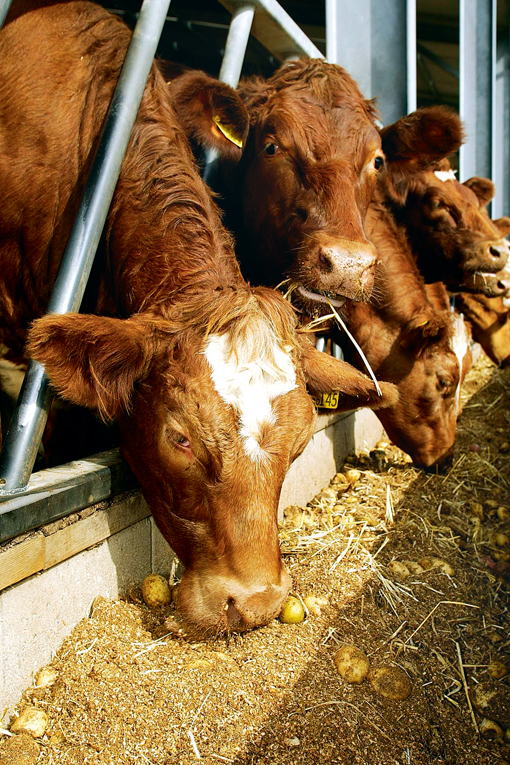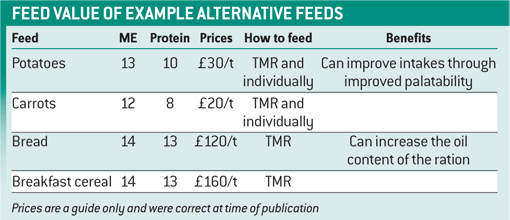Caution over alternative feeds
Soaring feed costs may be pinching beef and dairy farmers’ profits this winter, but there are alternative feed sources producers could use.
Farmers considering alterative feed products this winter in a bid to cut feed costs must carefully consider cost, quality and availability, nutritionists warn.
While there are plenty of opportunities for beef and dairy farmers to make use of a wide range of lesser-known “alternative” feeds – with many available as surplus supplies from the human food sector – some caution must be exercised, says nutritionist John Sanders, Cumbria.
“There are some good food sources on the market, and there are some that are not so good. So my advice to any farmer considering using new ingredients in cattle diets is to shop around – see what’s available, find out how much it costs and then get some advice on how it can most efficiently be used in your existing feed system.”
In addition to the wide range of popular moist-grain “alternative” feeds, enterprising beef and dairy farmers are looking at supplies of some of the more unusual feeds on offer such as fruit waste, chopped and cooked beetroot, pizza bases and Yorkshire puddings, as well as mixed vegetable feed material, potatoes, carrots and bread.
Despite some of these feeds being unconventional, Mr Sanders says there should be “no risk” involved in incorporating them into cattle rations provided they are of high quality and are correctly formulated into the diet.
“Farmers must base their decisions on cost, the quality of these feeds and their availability. It’s important to get advice on their keeping qualities and to plan how much has to be stored on the farm at any one time. There may also be some deterioration in nutritional value so that has to be considered. The biggest risk is starting to feed one of these products and then for supplies to dry up,” Mr Sanders warns.
Chocolates and sweets – and even liquid caramel – are also on the market in limited supplies this winter, but nutritionists urge caution.
“Acidosis is a risk with these high-sugar feeds and likewise with confectionary products from the bakery sector. They are high in fermentable energy and their use should be carefully monitored.”
Supplies of stock feed potatoes have been tight in some areas so far this season but it’s expected that availability will improve.
“Potatoes at 20% dry matter, 13% ME and around 9% protein are a good option to add energy to the diet. But choking has always been a potential problem when feeding potatoes so don’t take the risk – buy a chopper. It will cost less than a dead cow.”
COW HEALTH
Farmers thinking of exploring the market for “new” feeds to add to cattle diets this winter should have a chat with their vet before making any radical changes.
There’s all sorts of feeds out there, but the aim must be to make the most of them in terms of the diet without compromising cow health, says Cheshire vet Neil Howie, Nantwich Vet Group.
Among his “ones to watch” are citrus pulp because of the risk of mycotoxins when not fresh; chocolates and sweets which can be toxic; and potatoes because of choking risks when not chopped and fed with care.
“Farmers using potatoes should make sure loads are fresh and not fermenting to avoid health risks, and likewise for bread and cake – although a little mould on bread can be tolerated if it’s not excessive.”

CASE STUDY 1
Paul Turnock, Staffordshire: Dairy cows fed on stock potatoes
Staffordshire dairy farmer Paul Turnock has been using potatoes in the diet of his 350 cows for the last 10 years and rates them as an important part of the ration – every day of the year.
He says there’s no doubt potatoes stimulate intake levels of the TMR with cows running to the barrier to get them, but he stresses you have got to know what you are doing and feed them carefully.
His winter use is currently about two tonnes of potatoes a day, but experience has shown cows must be left undisturbed and allowed to eat their feed once the mix has been put in front of them.
“We’ve only had one case of a cow choking on a potato but the key is not to disturb them once they are at the barrier and eating. We leave them in peace for at least 45 minutes because it’s when they start moving around and become unsettled that choking can happen.”
Mr Turnock feeds a TMR diet based on grass and maize silage, with Trafford Gold and a home-mixed blend with potatoes added as energy sources.
“Cows are eating around 10kg of potatoes a day and we’ve been paying about £31 a tonne for washed loads. It used to be a lot easier to get hold of stock feed potatoes, but supplies have definitely tightened,” he adds.
In the past, the Turnock family has mixed potatoes with silage and clamped the mixture. “It worked well and the potatoes didn’t deteriorate, but we found we’d less control over the weight of potatoes the cows were eating so we prefer to add them as a separate constituent of the mix.”
CASE STUDY 2
Martin Grix, Northumberland: Cull cows feed on fruit and mash potatoes
Cull cows on Martin Grix’s farm in Northumberland are being finished on a diet that includes fruit waste and mashed potato. While these ingredients are reducing the cost of the ration – and yet still achieving a liveweight gain of just over 1kg a day – he says newcomers to these feeds must “do their homework” first.
“You’ve got to be organised, be able to cope with storing these feeds, make sure you can handle big tonnages and not risk deterioration when you aren’t using them quickly enough. And you must be sure they’re giving you the right nutritional input to the diet,” says Mr Grix.
He uses about 30 tonnes of fruit waste every week – comprising a wide range of fruit ssuch as apples, mangoes, melons and seasonal fruits – plus 29 tonnes of mashed potato.
“We’ve always got to be thinking ahead to make sure we’ve enough supplies. We’ve used frozen chips and peelings in the past, but were getting 20% wastage so that killed it on price.”
Cull cows – which he says become almost “addicted to fruit” during their 80-day finishing period – are fed 5kg of fruit a day as part of their 27kg daily intake of TMR. “Our feed costs are about £1.50 a cow a day and we’re costing home-grown barley into the mix at £150 a tonne and straw at £50 a tonne.

